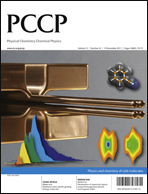Trapping molecular ions formed via photo-associative ionization of ultracold atoms
Abstract
The formation of 40Ca2+ molecular ions is observed in a hybrid 40Ca magneto-optical and ion trap system. The molecular ion formation process is determined to be photo-associative ionization of ultracold 40Ca atoms. A lower bound for the two-body rate constant is found to be ![[small beta, Greek, macron]](https://www.rsc.org/images/entities/i_char_e0c3.gif) ≥ 2 ± 1 × 10−15 cm3 Hz. Ab initio molecular potential curves are calculated for the neutral Ca2 and ionic Ca2+ molecules and used in a model that identifies the photo-associative ionization pathway. As this technique does not require a separate photo-association laser, it could find use as a simple, robust method for producing ultracold molecular ions.
≥ 2 ± 1 × 10−15 cm3 Hz. Ab initio molecular potential curves are calculated for the neutral Ca2 and ionic Ca2+ molecules and used in a model that identifies the photo-associative ionization pathway. As this technique does not require a separate photo-association laser, it could find use as a simple, robust method for producing ultracold molecular ions.

- This article is part of the themed collection: Physics and chemistry of cold molecules

 Please wait while we load your content...
Please wait while we load your content...